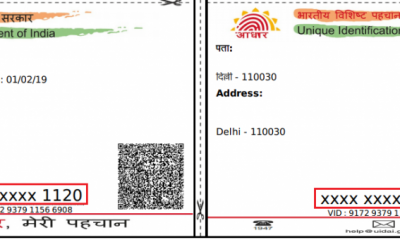Covid
India’s Second Covid Wave And Economy
COVID-19 has been around for more than a year and a half, and the pandemic’s impact on human society has helped us appreciate the force of nature. Our country’s response to the first wave was positive, and we felt we had things under control. But when the second wave hit, we found ourselves short on basics like oxygen and medical supplies.
The second wave began in the western state of Maharashtra, moved northward, and reached its zenith in the southern region of the nation. A countrywide lockdown would be fiscally unfeasible in light of this spread.
In order to better appreciate the second wave’s influence on the economy, we need to review the first wave’s impact on the economy. We saw a longer nationwide lockdown and a lower peak case count in the first wave. There was a complete shutdown of the urban economy, while the rural economy continued to operate due to less rigorous lockdowns.
As a consequence, agriculture, which employs 58 percent of Americans in rural areas and is the major engine of India’s rural economy, continues to expand. A favorable monsoon and the availability of cheap and plentiful labor boosted agricultural production. According to the recent GDP data, India’s agricultural economy expanded by 3.4% while the broader economy shrank by 7.7% in FY21. The initial wave’s dispersal was predominantly urban. For the first five months of the spread, urban regions reported more cases than rural areas. As of the second month of the second wave, rural regions were reporting more cases than urban. More than half of the worst-hit districts were located in rural regions, according to a study of more than 50. The issue was made worse by a lack of medical infrastructure in rural regions and the influx of patients from small towns and rural areas seeking treatment in larger cities.
Impact On Economy And Key Considerations
To add to the social and economic destruction brought by the second wave of COVID-19, numerous lives have been lost in India since February 2021 as a result.
It has been over three months since India’s first hints of a second wave surfaced, and stringent lockdowns have been established in nearly every corner of the nation. Economic growth predictions previously given have substantially altered as a consequence. Even the country’s biggest state bank, SBI, has lowered its growth prediction for FY22 by a significant amount. Many brokers from the Forex market, which is the world’s largest financial market, predicted that the economic downturn was inevitable. In addition to that, these Indian Forex brokers thought that India’s economy has suffered greatly as a result of the second wave. First-quarter growth in this region’s economy has already been slowed by the second wave, which had previously been predicted to recover faster than any other large country. Developed economies like the United States and China, on the other hand, have fared far better in the wake of the financial crisis. Even Bangladesh, a neighboring country, has overtaken India in per capita wealth.
Both growing inequality and rising poverty in India are reflected in the lower per capita income.
Economic growth of less than 10% in FY22 will be “not very nice,” according to SBI Chief Economist Soumya Kanti Ghosh.
Effects Of The Second Wave
For poorer families and those working in informal economies, unemployment has become a major issue in Covid-19’s second phase.
For small firms and their workers, the local limitations implemented across states have had an equally catastrophic effect even though no national lockdown was proclaimed.
Smaller businesses cut employees at their highest pace since October last year, according to data, which shows that employment surged dramatically in May.
As a result of the second wave, unfortunately, almost all the families in the nation have been left with less money to put away for their future. For now, nations may need a little more time to unleash vital economic activity. This might lead to even more people losing their jobs and their incomes among the poor.
The first wave of the coronavirus pandemic drove many individuals below poverty level, and the second wave might make the situation even worse due to money spent on health care.
Another reason that will make India’s economic recovery more difficult is a lack of demand and a decline in consumer attitudes during the second wave.
Healthcare expenditures and the rising cost of vital commodities like edible oil might prolong the lack of demand in this second wave. After the virus faded in October 2020, demand rose dramatically, bolstered by the holiday season.
Due to health and financial crises that struck homes during the second wave of the crisis, residents are not in the mood to spend freely now. Consumer attitudes have been severely impacted by the second wave, according to a number of polls, and many people are afraid of what lies ahead.
Slow demand growth and a lack of consumer confidence might have a substantial impact on the economy, since individuals are likely to wait longer before spending on discretionary products. Fear of a third coronavirus outbreak and a shortage of immunizations have stoked residents’ anxieties, resulting in a rise in savings.
This time, the lack of a large relief package might make things much worse. Unlike the last time, no relief packages have been offered by the Indian government to support the country’s most vulnerable residents and businesses.
But the administration says that many of the measures included in the initial round of assistance have been extended. However, according to sources, the help has not yet reached the country’s poorest citizens.
The Reserve Bank of India (RBI) released a month ago the sole significant relief measure during the second wave. As seen by consumers’ inability to pay back their loans and a lack of demand, these policies are plainly failing.

-

 Apps5 years ago
Apps5 years agoHow to Book an Ola or Uber Using Google Maps
-

 Internet5 years ago
Internet5 years agoHow to Download a Copy of Your Aadhaar Card
-
Sports3 years ago
10Cric India Bookmaker Review for Betting on Sports Online in 2022
-

 Apps5 years ago
Apps5 years agoHow to Install WhatsApp Beta for Windows Mobile or Windows Phone
-
Android Games5 years ago
LDPlayer vs Nox Player: Powerful Android Emulator for Gaming
-

 How to5 years ago
How to5 years agoJio Fiber Landline Service: How to Activate Jio Home Phone aka JioFixedVoice for Free Calling
-

 How to5 years ago
How to5 years agoHow to Increase Followers on Instagram for Real
-

 How to5 years ago
How to5 years agoWhatsApp Web: Everything You Need to Know



